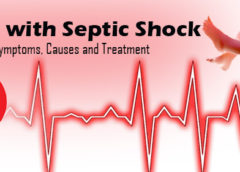What is abortion with septic shock?
Septic shock abortion is a medical termination of pregnancy. Abortion is a process that will end a pregnancy. Septic shock happens when the body is weakened by an infection which induces low blood pressure. Septic shock may affect someone susceptible to infectious germs. The septic shock can be a dangerous risk when linked with abortion.
Types of Abortions
There are different types of abortions:
• Spontaneous Abortion (miscarriage) happens when tissue from pregnancy passes from the body. There are two forms of this: “complete,†in which all the pregnancy tissue is passed and no intervention is required, and “incomplete,†in which only part of the pregnancy tissue is passed and usually requires intervention.
• Surgical Abortion is the removal of the fetus and placenta from a woman’s uterus. The doctor usually uses a vacuum to removes the pregnancy material.
• A Medical Abortion uses prescribed medicines. Such medicines enable a woman to pass the fetus and related tissue. The consequences are something is a miscarriage.
• Self-induced abortion is performed by the mother. This term includes abortions carried out with legitimate, over-the-counter medication and carried outperformed using unregulated, often dangerous methods.
Symptoms of abortion with septic shock
Septic shock is a medical emergency. If you have had an abortion recently and find any of the following symptoms, seek urgent medical help:
- Extreme high or low body temperature
- Extreme bleeding
- Extreme pain
- Feelings of confusion, restlessness, or fatigue
- Shaking Chills
- Low blood pressure, mainly when standing
- Inability to urinate
- Palpitations in heart
- Rising heart rate
- Painful fast breathing with short breath
Causes of abortion with septic shock
Septic shock often occurs after an abortion. It strikes when your body gets a bacterial infection.
In most cases, the infection stays in a given area. The infection, however, reaches the bloodstream in extreme situations and spread across the body. This is called a systemic response. The resulting condition is known as sepsis. Also, sepsis causes:
- Fast Heart Rate
- Rapid Breathing Rate
- Extremely High or Low White Blood Cell Count
When sepsis weakens the immune system in your body, your organs start to fail. If sepsis worsens the condition is called septic shock that the blood pressure drops dangerously low and is immune to treatment.
Two principal factors can contribute to the onset of sepsis and septic shock in abortion. They are:
• Incomplete abortion: pieces of pregnancy tissue remain in the body after a spontaneous or induced abortion, both medical and surgical
• Uterine bacterial infection during a surgical or self-induced abortion
Risk factors for abortion with septic shock
The chance for septic shock increases when bacteria are more likely to enter your bloodstream. Having any surgery or medical procedure puts you at an increased risk for septic shock.
A medical device can carry bacteria when it is inserted into your body. That increases the risk of infection and sepsis. The longer the device is in your body, the greater the chance of infection.
In a surgical abortion, the doctor uses a hollow tube vacuum to expel the fetus and placenta from the womb. Medical devices, such as catheters, drainage tubes, or breathing tubes will place put you at a similar risk of being infected.
The risk for septic shock is significantly increased in self-induced abortion when medical instruments are not used. There is less potential to avoid the spread of germs since many of the devices used are household things of daily use.
Complications of abortion with septic shock
Septic shock can be fatal unless properly treated. This can destroy any part of your body and cause organ failure.
Typical complications include:
- Body tissues die due to loss of blood
- Respiratory failure
- Liver failure
- Kidney failure
Treatment and Recovery
Septic shock is a medical emergency which required urgent care/treatment. Treatment also starts because of the urgency before test report confirms the diagnosis. When you have septic shock signs following an abortion, you need to be taken to an intensive care unit immediately.
Treatment for septic shock focuses on protecting vital organs and removing the source of infection.
Antibiotics are given first. Test results will take several days to determine the exact bacteria that cause sepsis. Two or three antibiotics can be combined to increase the chances of destroying the bacteria. A typical treatment with antibiotic involves a combination of:
- Ampicillin
- Gentamicin
- Metronidazole
Treatment can be refined once the bacteria are identified. Your chances of surviving septic shock increase when you receive antibiotics soon after the abortion.
Your treatment may include:
- Mechanical ventilation (breathing machine)
- Medication (to increase blood pressure)
- Intravenous (to increase fluid in the bloodstream and blood pressure)
- Oxygen
- Hemodynamic monitoring (evaluation of heart and lung pressure levels)
In certain cases, it needs surgery. You doctor can suggest a full hysterectomy if the infection is caused by matter from an abortion.
Your doctor may do a laparotomy in some cases. A laparotomy is an incision in the abdominal wall that allows for quick access to the abdominal cavity. It may be needed if your physician suspects the infection is caused by:
- Uterine Perforation
- Bowel Injury
- Abscess
- Soft Tissue Infection
How to prevent septic shock
Most cases of septic shock are not preventable. By taking these precautions you will reduce the risk:
- Consult a doctor about elective abortion.
- Follow the instructions for a legal abortion exactly as given.
- Never try a self-induced abortion.
- Be aware of the signs of bacterial infection after abortion of any kind.
- Get treatment for infection as soon as possible.

Leave a Reply
You must be logged in to post a comment.